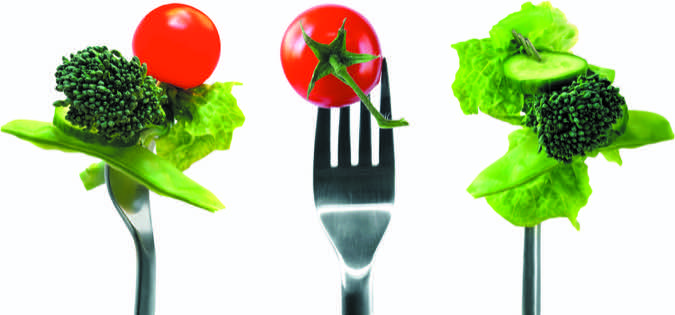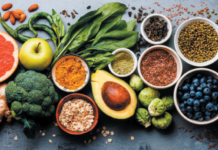Image © Macrovector | Dreamstime.com


Whether you’re hosting or attending a holiday meal, chances are that one or more guests are restricting something from their diets. Watching salt intake is one of the more common dietary restrictions, according to an online poll of American households. But, a good portion of people limit or avoid items like lactose (natural milk sugar), meat, refined carbohydrate/sugar, gluten (a protein in certain grains) or commonly-allergenic items like milk (dairy), peanuts and tree nuts. So, how can you all come together to enjoy a meal?
“Good communication is essential,” says Kelly Kane, MS, RD, director of nutrition and business operations at the Frances Stern Nutrition Center at Tufts Medical Center. “Some people are very vocal about their dietary needs and preferences, while others may be worried about offending people and may not say anything. But, if someone has a life-threatening food allergy, for example, it’s important to share that information.”
At the same time, Kane notes that not every dietary preference needs to be shared, unless you’re following a strict regimen. For example, if you’re dabbling with vegetarianism but haven’t fully committed to it, that’s probably not essential to communicate. But if you’re a strict vegan and wouldn’t consider eating any ingredients from animals, let your host know.
General Tips for Hosts:
If you’re hosting the meal and aren’t already familiar with guests’ dietary needs, just ask. That doesn’t mean you have to meet everyone’s needs to the last detail, but asking will help ensure everyone can find something to eat. “The degree to which you accommodate dietary restrictions will depend on the size of your guest list and your comfort in the kitchen,” says Alicia Romano, MS, RD, who specializes in dietary counseling for digestive issues at the Frances Stern Nutrition Center at Tufts Medical Center. The following general tips can help make meals more broadly acceptable and accommodating for all.
Consider serving the meal buffet-style. That enables guests to easily choose what works for them. You can include a mix of traditional favorites and diet-friendly dishes. If you have enough different items, most people can eat
around their dietary restrictions.
Offer simply-prepared dishes. “Dishes with fewer ingredients make it easier for guests to know what they’re eating, and such dishes tend to be healthier, too,” Kane says. For example, toss cooked green beans with olive oil, dried cranberries and toasted pumpkin seeds (or nuts, if no guests are allergic to them).
Serve toppings on the side. “If a dish has a gravy or sauce, serve it on the side so guests can decide whether or not they want to include it,” Kane says. Similarly, offer salad dressing and extras like croutons or shredded cheese on the side.
Keep recipes handy. Guests avoiding animal ingredients or allergens may ask what’s in a dish. If people are bringing dishes to share, ask them to write their name and the recipe (or at least the ingredients) on a recipe card to place by the dish. Guests who just want a copy of the recipe will appreciate this, too.
Offer some non-alcoholic but festive drinks. Some guests may need to avoid alcohol due to medications, pregnancy, addiction issues or other health conditions. Many recipes for “mocktails” (non-alcoholic mixed drinks) can be found online. Flavored (unsweetened) sparkling water can be festive, too.
Heart-Healthy & Diabetes-Friendly Hints:
Everyone should follow a heart-healthy diet, but people with chronic heart conditions may be more closely watching their sodium (salt) intake. And, guests with diabetes will be watching their carbohydrate intake.
Consider meal timing. Tell guests what time the meal will be served, especially if it’s outside the norm, like mid-afternoon. Guests with diabetes, especially those using insulin injections to control blood sugar, may need to plan ahead so their blood sugar doesn’t dip due to a delayed meal. If people will be gathering a while before the meal, set out some healthful appetizers, like fresh vegetables with hummus dip or cheese with whole-grain crackers.
Share the menu in advance. “Sometimes guests don’t feel comfortable communicating that they have diabetes, high blood pressure or other chronic conditions,” Kane says. “So, it can help to give guests an idea of what will be served so they can plan appropriately.”
Watch the salt. Add minimal salt to dishes, letting guests add more if desired. Opt for low-sodium or reduced-sodium ingredients when you can.
Be carbohydrate-aware. Don’t assume people with diabetes will skip dessert (they may eat a small portion if they plan for it). And, they may be limiting other carbohydrate-rich foods (examples, right). Carb-conscious guests will appreciate non-starchy vegetable offerings like a pretty salad of mixed leafy greens or roasted Brussels sprouts.
Vegetarian, Vegan and Other Lifestyle-Based Preferences:
There are many variations of vegetarianism (details, left), so it’s best to ask specifically what guests avoid. Try to make sure there will be some dishes they can eat, but without causing yourself too much extra work or causing them to feel self-conscious.
Opt for vegetarian or vegan ingredients, when you can. If a recipe like stuffing, soup or a side dish calls for broth, opt for vegetable broth rather than chicken broth.
Make hearty side dishes that do double-duty as a vegetarian or vegan main dish. For example, try our Quinoa Pilaf with Dried Cranberries & Roasted Squash recipe, right. Or, make a baked bean dish or three-bean salad.
Share food source information. If guests have strong food philosophies, like eating only organic food, tell them what types of foods you’re going to use and that they’re welcome to bring dishes to share that fit their food philosophy. That can help minimize conflict at the gathering, Kane says.
Food Allergies, Intolerances and Other Sensitivities:
This can be a trickier area to navigate since a person with a food allergy could have a life-threatening reaction to a food, while someone with food intolerances may feel unwell after eating the wrong foods and may have a long list of foods that bother them.
“Successfully hosting an allergy-friendly meal doesn’t mean you have to ban all foods to which guests have allergies or intolerances,” Romano says.
“But, you should be in good communication with them and aware of their restrictions to ensure there will be something they can eat at the gathering.”
Retain product details. “Keep food package labels of what you’ve used to prepare menu items so guests with allergies can double-check ingredient lists,” Romano says. Or, snap photos of the packages (including the complete ingredients list) on your smartphone.
Take extra care with main dishes. Watch out for sneaky additives in turkey and other meats, Romano says. Some turkeys are pre-basted or pre-seasoned and may contain allergens like soy or wheat (gluten), so check ingredients at the store. She also advises cooking stuffing separately rather than inside the bird. That helps avoid cross-contaminating the turkey meat with wheat/gluten from bread crumbs.
Be careful in food prep. “If someone has a food allergy, simply rinsing a cutting board or knife used on a food that contains an allergen (like wheat or nuts) isn’t enough,” Romano says. “Even trace amounts of an allergen can cause a harmful reaction for highly allergic people. So, thoroughly scrub all utensils, food-preparation surfaces and your hands with soapy water after they’ve come into contact with food allergens.”
Be vigilant with serving utensils. If some guests have food allergies or gluten sensitivity, consider having them serve themselves first to avoid cross-contamination from a serving utensil (or dropped food) that ends up in the wrong dish. For example, there’s a risk that someone may use the wrong (contaminated) pie server in the gluten-free pie. “When possible, put allergen-free dishes in a separate area to avoid such mix-ups and cross-contamination,” Romano says.
Do only what you’re comfortable with. If you’ve never baked with gluten-free flours, you don’t have to take it on yourself. Your guest may volunteer, or there may be ready-made gluten-free items you can purchase. Some companies sell good gluten-free baking mixes, like gluten-free cornbread, which everyone can enjoy. But be careful not to add gluten during preparation. For example, make sure the baking pan is completely clean (without old residue), and swap gluten-free flour for all-purpose wheat flour to prep a pan for baking.
Be a Thoughtful Guest:
Hosting a holiday meal is no small feat, so do what you can to help out the host and minimize worry if you’re following a special diet.
Give them a heads up. As soon as you’re invited, let hosts know your diet restrictions, so they don’t have to scramble at the last minute or feel hurt if you don’t eat their special dishes.
Offer to bring a dish. Let hosts know that you don’t expect them to make anything special for you. Offer to bring a favorite dish to share, which ensures there’s something you can eat. Consider bringing a one-pot-meal, such as a hearty salad or casserole, in case there’s nothing else you can eat.
Applaud well-intended efforts, but be honest when they won‘t work for you. If someone makes a casserole, for example, but overlooks the gluten in the condensed soup in the dish, thank them but don’t risk your health by eating it.
Polish your elevator speech. You might be put on the spot to explain why you’re passing up certain dishes. Or, guests may ask why you’re eating something they think you shouldn’t have. Kane suggests saying something like, “Thanks for your concern, but this is what works best for me.”
Special dietary needs shouldn’t divide us at the holiday table. All it takes to come together and enjoy each other’s company over a meal is good communication, a bit of understanding and pitching in to help as needed.
To learn more: Journal of the Academy of Nutrition and Dietetics, December 2016
To learn more: Annals of Allergy, Asthma & Immunology, September 2017
To learn more: JAMA, August 2017


There are several different types of vegetarians. And vegans may follow slightly different rules, too. To be certain what people include or omit from their diets, just ask. Heres a general guide.
– Pescovegetarian or pescetarian: Includes fish and other seafood but no meat or poultry.
– Vegetarian: General term for a diet without meat, poultry or fish (flesh foods). May or may not include eggs or dairy products.
– Ovo-vegetarian: No flesh foods or dairy products but eats eggs.
– Lacto-vegetarian: No flesh foods or eggs but eats dairy products.
– Lacto-ovo-vegetarian: No flesh foods but eats eggs and dairy products.
– Vegan: No flesh foods, eggs or dairy products/ingredients. May omit honey, too.
– Raw vegan: Diet is based on vegetables, fruits, nuts, seeds, legumes and sprouted grains. The amount of uncooked food varies from 75 to 100%.
Source: Position of the Academy of Nutrition and Dietetics: Vegetarian Diets


Some carbohydrate-heavy dishes may surprise you. I always caution people with diabetes about cranberry sauce, Kane says. Its just so high in carbohydrate, it can have a big impact on blood sugar. A ¼-cup serving has 23 grams carbohydrate, which might be a third or half of a persons allowance for the entire meal. Here’s a sampling of other carbohydrate-rich holiday dishes:
Note: carb = carbohydrate, g = grams, oz = ounces
Sources: American Diabetes Association
























